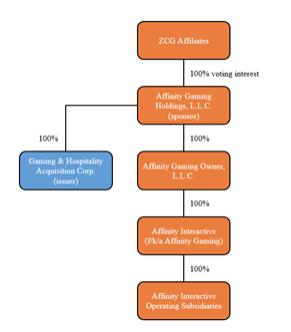The current organizational structure of our Sponsor, Affinity Interactive (f/k/a Affinity Gaming) and us is as follows:

Affinity Interactive (formerly Affinity Gaming)
Affinity Interactive, an indirect wholly owned subsidiary of our Sponsor, is controlled by entities managed by affiliates of Z Capital Partners, L.L.C. Affinity Interactive’s offerings consist of regional gaming, online wagering, sports betting, and digital and media platforms operating through two divisions: Affinity Gaming and Sports Information Group, LLC.
Affinity Gaming is a diversified casino gaming company headquartered in Las Vegas, Nevada that owns and operates eight casino properties across the United States, five of which are located in Nevada, two in Missouri and one in Iowa. Our management team, Affinity Interactive or its affiliates are currently licensed or have been found suitable to conduct gaming operations in four states – Nevada, Missouri, Iowa, and Florida – and previously maintained licenses in an additional eight states including Colorado, New Jersey, Pennsylvania, Ohio, Mississippi, Indiana, Louisiana and Arizona. Please see the section of our final IPO prospectus filed with the SEC on February 4, 2021 entitled “” for additional information with respect to the Affinity Gaming business. Affinity Gaming was acquired by entities managed by affiliates of ZCG in 2017.
Affinity Gaming Business
On July 1, 2021, Affinity Gaming acquired Sports Information Group, LLC (d/b/a Daily Racing Form LLC) (“SIG”), a separate portfolio company wholly-owned by investment funds managed by affiliates of Z Capital Partners, L.L.C., and changed its name to Affinity Interactive. Affinity Interactive remains an indirect, wholly owned subsidiary of our Sponsor, Affinity Gaming Holdings, L.L.C., and our Sponsor remains controlled by entities managed by affiliates of Z Capital Partners, L.L.C. SIG is a New York based global omnichannel, gaming, technology, media and digital information company dedicated to providing premium data driven content and
in-depth
information to the horse racing industry, including through its flagship brand “Daily Racing Form.” 5